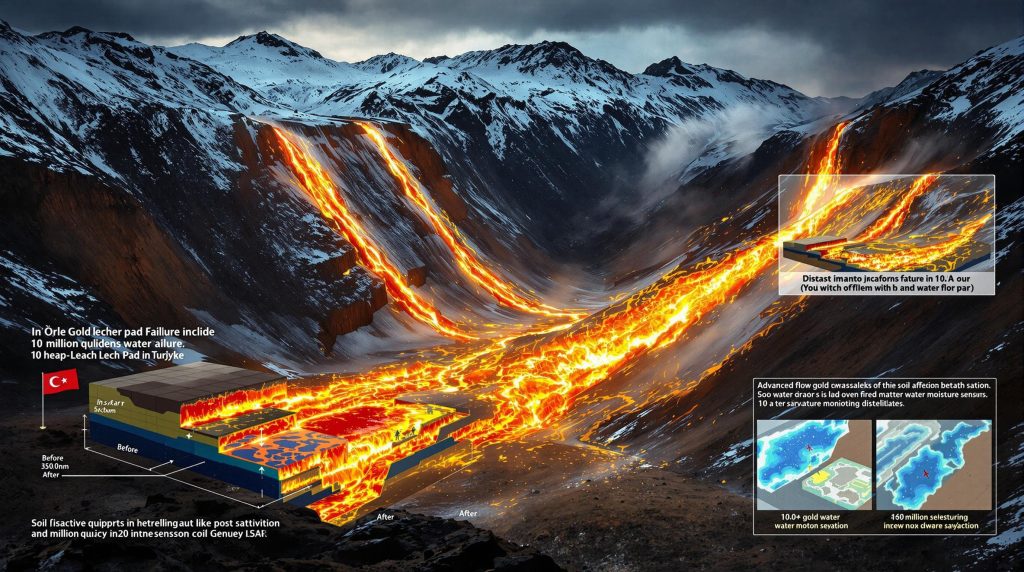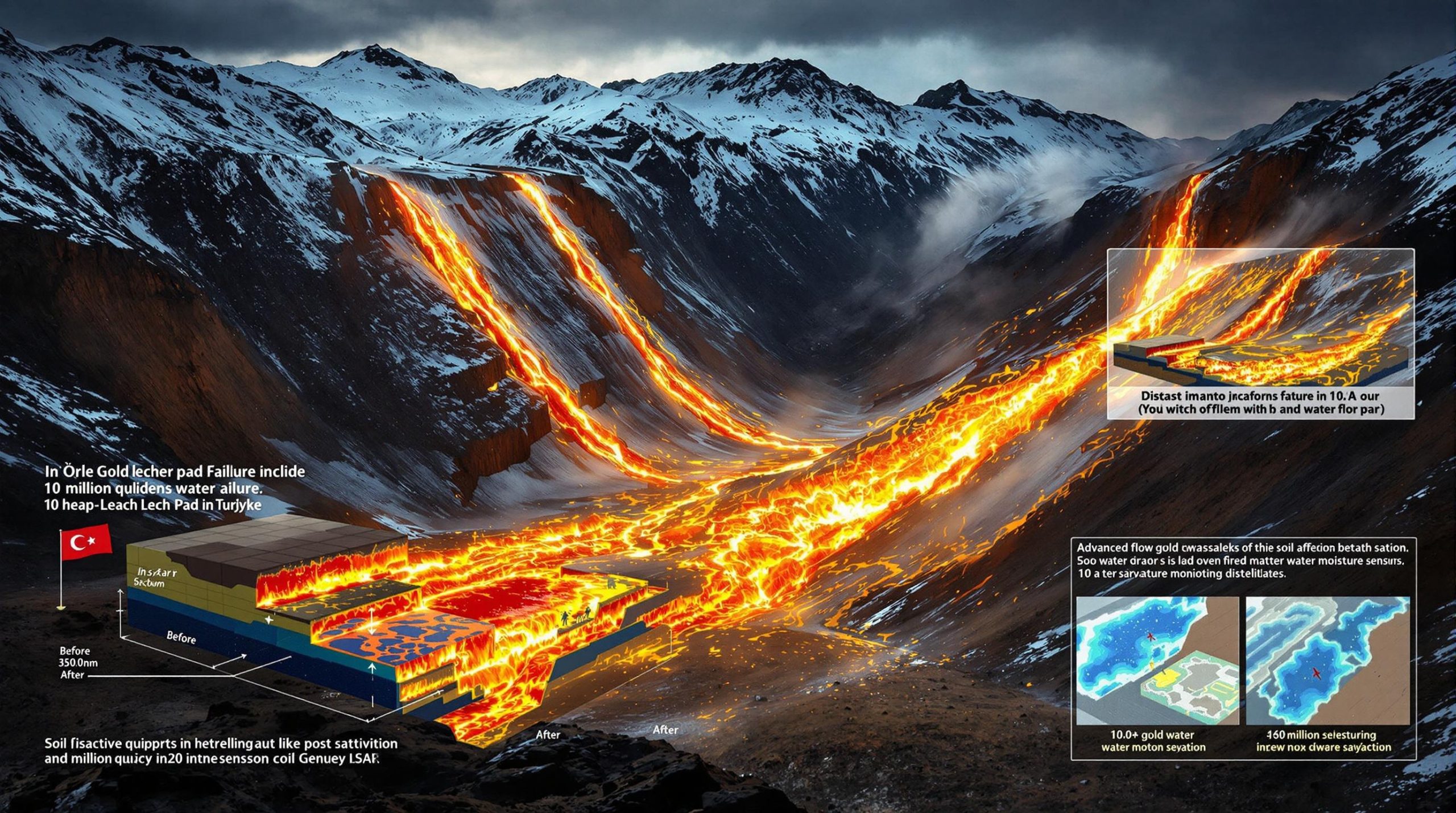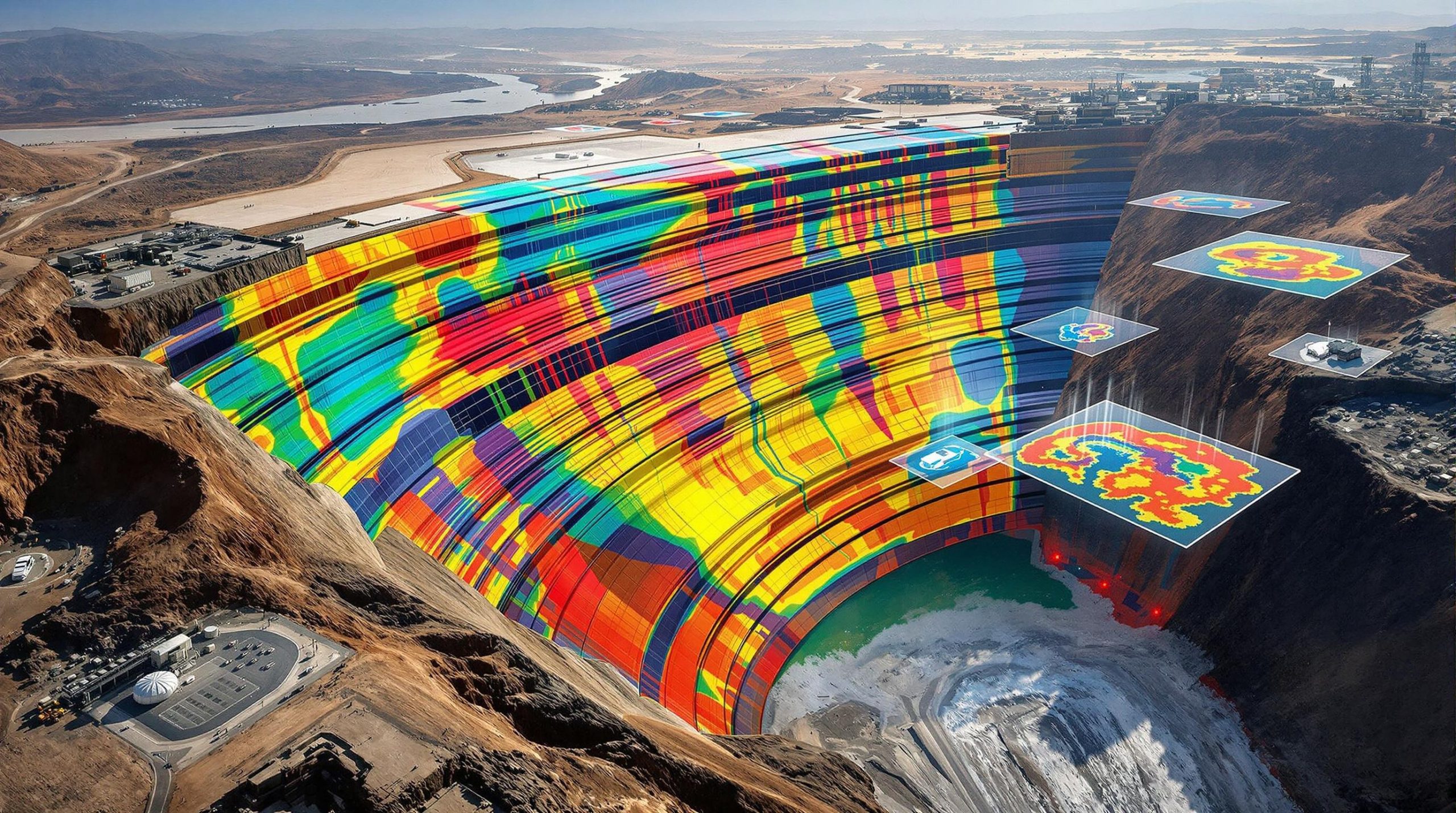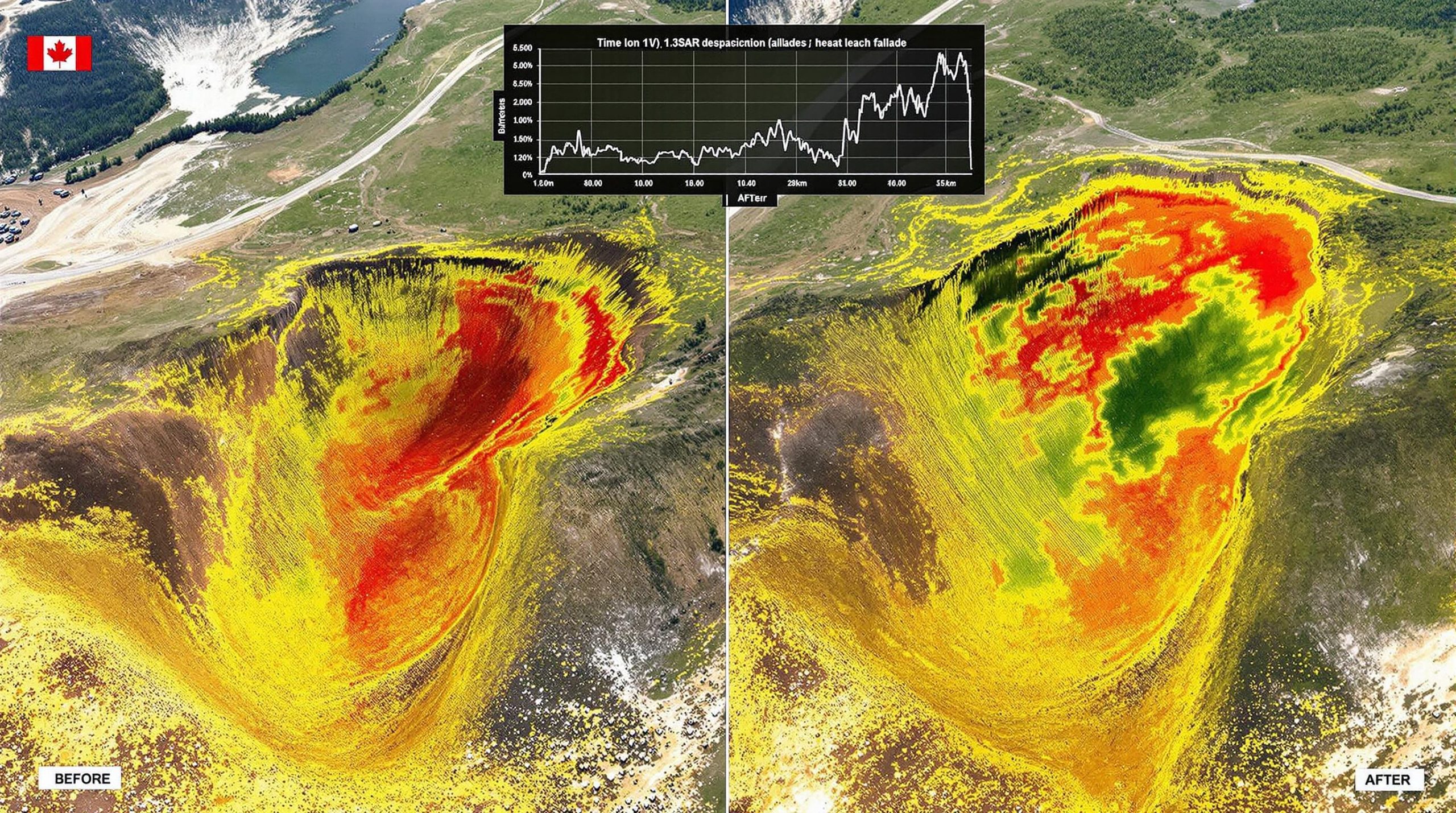The Çöpler Gold Mine Disaster: Causes, Impacts, and Prevention Strategies
On February 13, 2024, eastern Türkiye experienced one of the most devastating mining disasters in recent history when the heap leach pad at the Çöpler Gold Mine catastrophically failed. This event not only claimed nine lives but also raised serious questions about mining industry trends and disaster prevention strategies in the industry.
The Catastrophic Failure Event
The disaster unfolded over just 30 seconds, yet its consequences were profound. Approximately 10 million cubic meters of material mobilized in a high-velocity flowslide, creating a retrogressive failure pattern that tore through the steep valley terrain. The scale and speed of the collapse left little time for evacuation or emergency response.
Video footage of the event reveals the terrifying progression of the failure—starting with initial movement at the toe of the heap leach pad and rapidly propagating backward through the structure. The resulting flowslide exhibited fluid-like behavior, allowing the material to travel significant distances at high velocity.
The human toll was devastating: nine workers lost their lives, and substantial infrastructure was destroyed in the path of the flowslide. Recovery efforts were hampered by the massive volume of displaced material and difficult terrain.
Geographic and Operational Context
Located in the mountainous eastern region of Türkiye, the Çöpler Gold Mine had been a significant economic contributor to the area. The operation featured an oxide heap leach pad—a common structure in gold mining where crushed ore is stacked and treated with cyanide solution to extract gold.
Prior to the disaster, the heap leach pad had been constructed in accordance with industry standards, with multiple lifts of crushed ore stacked over time. The mine's location in a valley setting with significant topographic relief created both operational challenges and inherent risk factors that would later prove critical.
The mine had operated for several years without major incidents, though a comprehensive review of its safety record would require access to operational history that isn't publicly available. According to BBC reports, the operation's importance to the local economy made the disaster's impact particularly acute for surrounding communities.
Why Did the Heap Leach Pad Fail?
Critical Environmental Triggers
The disaster's timing correlates directly with specific environmental conditions that created a perfect storm of risk factors. January 2024 brought extensive snow accumulation to the region, followed by an unusually rapid warming period in early February.
This dramatic temperature shift triggered accelerated snowmelt, releasing large volumes of water that infiltrated the heap leach pad structure. The rapid introduction of water into the previously stable structure fundamentally altered its geotechnical properties and triggered the catastrophic failure.
Weather data from the months preceding the disaster shows precipitation anomalies that contributed to saturated ground conditions even before the final triggering event. This highlights how cumulative environmental factors can create pre-failure conditions that make structures increasingly vulnerable over time.
Geotechnical Failure Mechanisms
The technical mechanics of the failure involve several interrelated processes that transformed a stable structure into a catastrophic flowslide:
-
Rising pore water pressure – As water infiltrated the heap leach material, it filled the spaces between soil particles, creating pressure that worked against the material's internal strength.
-
Reduction in effective stress – This increased pore pressure reduced the effective stress between particles, severely compromising the material's shear strength.
-
Material weakening – Research by Abdulkareem (2019) demonstrates that soil shear strength can decrease dramatically with increased moisture content, sometimes by 50% or more when approaching saturation.
-
Transition to flowslide conditions – Once the material's strength fell below the stress imposed by its weight and geometry, it transitioned from a solid-like state to a fluid-like behavior characteristic of flowslides.
-
Retrogressive failure pattern – The initial failure at the toe of the structure removed support for the material above it, creating a chain reaction that propagated backward through the heap leach pad.
Heap Leach Pad Vulnerabilities
Heap leach pads possess inherent structural vulnerabilities that make them particularly susceptible to moisture-related failures:
-
Material heterogeneity – The crushed rock and ore materials in heap leach pads vary in size, density, and permeability, creating unpredictable water flow paths and pressure zones.
-
Chemical processes – The ongoing leaching process involves the continuous application of solution, creating zones of varying moisture content and potentially weakening material bonds over time.
-
Geometric challenges – The typical stepped configuration of heap leach pads creates potential slip surfaces and concentrates water at certain levels.
-
Scale factors – The sheer size of modern heap leach pads amplifies the impact of even small changes in moisture content, with millions of cubic meters of material affected simultaneously.
"When designing heap leach facilities, engineers must account not just for normal operating conditions, but for extreme environmental scenarios that may occur only once in decades. The Çöpler disaster demonstrates how rapidly conditions can deteriorate when critical thresholds are crossed." – Mining safety expert quoted in technical analysis of the event
How Could Advanced Monitoring Have Prevented the Disaster?
InSAR Technology as a Predictive Tool
Interferometric Synthetic Aperture Radar (InSAR) technology represents one of the most promising tools for preventing similar disasters. This satellite-based remote sensing technique can detect ground movement with millimeter-scale precision across vast areas.
Retrospective InSAR analysis of satellite data covering the Çöpler site revealed a crucial missed opportunity: the heap leach pad showed measurable surface displacement patterns in the weeks and months before the catastrophic failure. According to recent research, the site was actually moving for four years before the failure, indicating classic warning signs that went unaddressed.
InSAR works by comparing radar images taken from the same position at different times, creating "interferograms" that reveal subtle changes in surface elevation. Modern InSAR systems can detect vertical movements as small as 1-2 mm, making them ideal for monitoring mining structures where even minor deformation can signal developing problems.
The technology offers several key advantages for mining operations:
- Wide-area coverage without requiring on-site equipment
- Regular data collection regardless of weather conditions
- Historical baseline comparisons to identify developing trends
- Early detection of movement patterns invisible to the naked eye
The Critical Role of Soil Moisture Monitoring
While deformation monitoring is essential, the Çöpler disaster highlights that soil moisture is not merely a secondary factor—it is often a primary driver of geotechnical failures. Modern data-driven mining operations can provide crucial information on changing conditions within mining structures.
These technologies work by measuring differences in microwave emissions or reflections from the Earth's surface, which vary with soil moisture content. When integrated with stability assessments, this data can help identify when structures are approaching critical moisture thresholds that compromise stability.
Research by Lees (2020) demonstrates that pore water pressure is directly linked to slope failures in mining environments, with clearly identifiable thresholds that indicate increasing risk. By monitoring these parameters, operations can implement preventative measures before conditions deteriorate to the point of failure.
Warning Signs That Were Missed
The Çöpler gold mine disaster appears to have exhibited several detectable warning signs that, if properly monitored and interpreted, could have triggered preventative action:
-
Surface displacement patterns – Satellite data analysis indicates measurable ground movement occurred prior to the collapse, with patterns showing 0 to -60 mm Line of Sight displacement from April 2022 to February 2024.
-
Accelerating deformation trends – The rate of movement typically increases as failure approaches, providing a critical window for intervention.
-
Environmental indicators – The combination of heavy snowfall followed by rapid warming represented a known risk scenario that should have triggered enhanced monitoring.
-
Water management anomalies – Changes in seepage, drainage patterns, or water balance could have indicated increasing saturation levels within the structure.
The challenge often lies not in data collection but in data interpretation and communication. Mining operations frequently maintain separate departments for environmental monitoring, geotechnical engineering, and operations, creating silos that prevent holistic risk assessment. Cross-functional interpretation teams are essential to connect the dots between different warning signals.
How Does Moisture Affect Mining Structure Stability?
Soil Mechanics Under Changing Moisture Conditions
The relationship between moisture and mining structure stability involves several fundamental geotechnical principles:
-
Reduced shear strength – As documented by Abdulkareem (2019), increased water content reduces the friction between soil particles, decreasing the material's ability to resist sliding forces.
-
Elevated pore pressure – Water between particles builds internal pressure that counteracts the weight of overlying material, reducing effective stress and stability. Lees (2020) demonstrated how critical this factor becomes in large mining structures.
-
Weight increase – Saturated soils are substantially heavier than dry soils, increasing the gravitational forces driving potential failures. Research by Tetteh et al. (2025) quantified this effect in mining environments, showing weight increases of 15-25% at saturation.
-
Liquefaction potential – Under certain conditions, saturated granular materials can suddenly behave like fluids when disturbed. Hakro and Harahap (2015) documented how this transformation can trigger high-velocity flowslides similar to what occurred at Çöpler.
These mechanisms don't operate in isolation—they interact and reinforce each other, creating a potentially rapid deterioration in stability once critical thresholds are crossed.
Moisture Impact Measurement and Monitoring
The mining industry employs several approaches to monitor moisture content and its effects:
Field measurement techniques:
- Time-domain reflectometry probes
- Electrical resistivity surveys
- Neutron moisture meters
- Piezometers for direct pore pressure measurement
Remote sensing approaches:
- Satellite-based microwave radiometry
- Ground-penetrating radar
- Thermal infrared imaging
- Passive microwave sensors
Laboratory testing protocols:
- Direct shear testing at varying moisture contents
- Triaxial compression tests under saturated conditions
- Soil-water characteristic curve determination
- Hydraulic conductivity testing
The challenge lies in implementing comprehensive monitoring systems that can detect dangerous changes before they lead to failure. Real-time monitoring systems that combine multiple sensor types offer the most reliable approach, especially when connected to automated alert systems.
Case Studies of Moisture-Related Mining Failures
While each mining failure has unique aspects, the fundamental mechanisms at work in the Çöpler disaster follow patterns seen in previous events. Historical precedents demonstrate how moisture-related factors have repeatedly contributed to catastrophic failures:
- Tailings dam failures following heavy rainfall events
- Waste rock dump collapses during spring thaw periods
- Pit wall failures after extended wet seasons
- Previous heap leach pad instabilities linked to irrigation system malfunctions
These cases consistently show that water is often the trigger that converts a marginally stable situation into an active failure. Success stories in the industry typically involve operations that implemented comprehensive moisture monitoring and management systems, enabling them to take preventative action when conditions deteriorated.
What Lessons Should the Mining Industry Learn?
Best Practices for Mining Structure Safety
The Çöpler disaster highlights several critical areas where industry practices must evolve:
-
Continuous environmental monitoring – Weather patterns, especially precipitation and temperature fluctuations, must be continuously monitored and incorporated into real-time risk assessments.
-
Integration of multiple data streams – Deformation data, moisture content, pore pressure readings, and operational information must be analyzed together rather than in isolation.
-
Cross-functional interpretation teams – Engineers, geologists, environmental specialists, and operations personnel need formal structures for collaborative risk assessment to prevent critical warnings from being missed.
-
Trigger action response plans (TARPs) – Clear, predetermined response protocols must exist for various warning indicators, removing ambiguity about when intervention is necessary.
-
Regular stability reassessment – Changing weather patterns or operational adjustments should automatically trigger comprehensive stability reviews.
"Environmental monitoring must be continuous and proactive, not periodic and reactive. The Çöpler disaster demonstrates how rapidly conditions can deteriorate when critical environmental thresholds are crossed."
Technology Integration for Enhanced Safety
The path forward for mining safety clearly involves better technology integration:
InSAR + soil moisture monitoring:
Combining satellite-based deformation detection with moisture content analysis creates a powerful approach to modern mine safety. This integration provides complementary data streams that together offer a more complete picture of developing risks.
Real-time alert mechanisms:
Automated systems can continuously analyze incoming data against predetermined thresholds, triggering alerts when concerning patterns emerge. These systems reduce reliance on human interpretation and ensure timely notification of potential problems.
Data fusion approaches:
Advanced analytics and AI-enhanced mining operations can identify subtle correlations between different monitoring parameters, potentially detecting developing problems before they would be apparent through conventional analysis.
Cost-benefit considerations:
While implementing comprehensive monitoring systems requires investment, the financial consequences of a major failure—including human lives, environmental damage, operational losses, legal liabilities, and reputational harm—far outweigh these costs.
Regulatory and Industry Response
The Çöpler disaster will likely trigger significant regulatory and industry responses:
- Updated safety standards with specific requirements for moisture monitoring and management
- Enhanced transparency requirements for monitoring data
- Independent third-party review of critical mine structure designs
- More stringent emergency response planning and testing
- Increased focus on climate change impacts in mine planning and risk assessment
The mining industry faces a choice between proactive self-regulation or potentially more restrictive government intervention. Companies that voluntarily adopt enhanced safety practices and sustainable mining practices may gain competitive advantages through reduced operational risks and improved stakeholder relations.
How Can Future Mining Disasters Be Prevented?
Comprehensive Monitoring Framework
A truly effective approach to preventing future disasters requires a monitoring framework that addresses multiple risk dimensions:
Integrated monitoring approach:
- Satellite-based InSAR for wide-area deformation detection
- Ground-based radar systems for high-frequency monitoring of critical areas
- Distributed fiber optic sensing for real-time strain and temperature measurement
- Automated piezometer networks for pore pressure tracking
- Weather stations and soil moisture sensors
- Regular visual inspections and drone surveys
Critical threshold establishment:
- Material-specific stability parameters based on laboratory testing
- Rate-of-change triggers that identify accelerating problems
- Cumulative effect thresholds that consider multiple factors simultaneously
- Seasonal adjustment of warning levels based on environmental conditions
Early warning system design:
- Automated data processing and alert generation
- Multiple notification pathways to prevent single-point failures
- Clear escalation procedures with defined responsibility chains
- Regular testing and validation of the entire system
Continuous vs. periodic monitoring:
- Critical structures require truly continuous monitoring rather than periodic assessment
- Real-time data transmission and analysis capabilities
- Redundant systems to ensure monitoring continuity
Emergency Response Planning
Even with the best monitoring systems, emergency response capabilities remain essential:
Evacuation protocols:
- Clearly marked evacuation routes with multiple options
- Regular drills and training for all personnel
- Automated notification systems with redundant communication paths
- Predetermined assembly points and accountability procedures
Communication systems:
- Multi-channel emergency notification capabilities
- Backup power and communication infrastructure
- Clear chain of command for emergency decisions
- Pre-established coordination with local emergency services
Training requirements:
- Regular scenario-based training exercises
- Role-specific emergency response training
- Validation testing of response capabilities
- Documentation and lessons-learned processes
Community involvement:
- Transparent communication with surrounding communities about potential risks
- Community inclusion in emergency planning processes
- Regular updates on monitoring results and safety measures
- Collaborative emergency response exercises
Long-term Industry Transformation
Preventing future disasters requires fundamental changes in how the mining industry approaches risk:
Designing inherently safer structures:
- Flatter slopes and more conservative geometry
- Enhanced drainage systems with redundant capacity
- Compartmentalized designs that limit failure propagation
- Material selection based on stability under worst-case conditions
Alternative processing methods:
- In-situ recovery techniques that reduce or eliminate large waste structures
- Dry stacking approaches for tailings management
- Paste backfill systems that return waste to mined-out areas
- Processing methods that reduce water usage and associated risks
Knowledge sharing platforms:
- Anonymous incident reporting systems for near-misses
- Industry databases of failure case studies
- Collaborative research initiatives focused on structure stability
- Open-source monitoring and analysis methodologies
Research priorities:
- Climate change impacts on mine structure stability
- Advanced monitoring technology development
- Improved material testing and characterization methods
- Enhanced modern mine planning technology for complex failure mechanisms
FAQ: Understanding Mining Structure Failures
What makes heap leach pads particularly vulnerable to failure?
Heap leach pads face several unique vulnerability factors:
-
Material heterogeneity – Unlike engineered dams or embankments, heap leach pads contain varied materials with inconsistent properties, creating unpredictable behavior under stress.
-
Chemical processing effects – The continuous application and circulation of leaching solutions creates dynamic moisture conditions that can evolve over time.
-
Scale and geometry considerations – Modern heap leach pads can reach enormous dimensions, with
Want to Be Alerted to the Next Major Mineral Discovery?
Don't miss out on significant ASX mineral discoveries that could lead to substantial investment returns. Discover how Discovery Alert's proprietary Discovery IQ model provides real-time notifications of major mineral discoveries by exploring their dedicated discoveries page.




